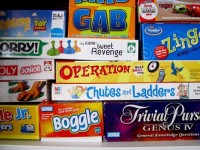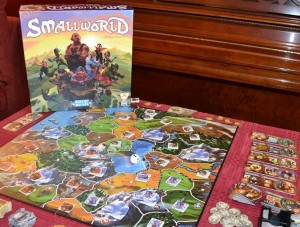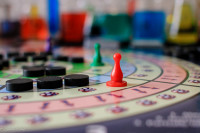Educational Board Games in the Classroom
With school starting back up again, we’ve heard a lot about teachers using board games in the classroom to better engage students. Lest you think your kids will be playing games at school all day, we thought it would be good to share a guest article on the subject from educator, Daniel Dulek.
USING EDUCATIONAL BOARD GAMES IN THE CLASSROOM
by Daniel D. Dulek
Educational board games have received a bad rap over the years. And rightly so–they tend to be nothing more than review questions or flash cards without much thought to creativity, originality, or real engagement.

Roll the dice, answer the questions, be the first to get to the end, and you win the game.
Creating a really good educational board game can be tricky. A delicate balance exists between ensuring the game’s educational component is solid and maintaining the entertainment value of the game so students don’t tune out!
Many games put so much emphasis on the educational component that the fun element is lost or the “fun” aspect of the game has little-to-no educational value. This lack of balance has left many teachers with a very negative view of educational board games.
To make matters worse, the current generation has become so immersed in technology that the mention of a board game results in sighs and eye rolls. It seems that most people prefer the electronic version of games, books, tools, and anything else available.

When I presented my first game to various distributors, many of them would ask, “Do you have an app version of your game?”
This fixation on technology is all very unfortunate because I believe that modern board games are far superior to video games and provide a great environment for learning.
With their innovative new game play, board games have made a huge comeback recently. Many of today’s board games have little in common with the games most adults grew up playing.
While some of those games may remain sentimental favorites, the newest generation of board games has much more to offer. They are imaginative, creative, intellectually stimulating, and just plain fun.
In this article, I’ll share the reasons teachers (and everyone else) should play more board games!
SO, WHY “REVERT” TO BOARD GAMES?
Sure, flashy video games and other forms of slick technology grab students’ attention, but physical board games have much more to offer the average child and teenager.
Don’t get me wrong; I love technology and video games. They do have value in our culture and society. But comparatively speaking, they take a backseat to board games when it comes to their educational value!

Here are some of the benefits of playing more board games in the classroom:
1. Overcoming Intimidation
The joy of playing a game removes the intimidation of learning a new concept. Learning something new is often overwhelming for students. Educational games create an environment where students use content-specific vocabulary and apply subject-specific concepts as they play a related game. As students play the game, they become more comfortable with the vocabulary and subject material while enjoying the experience. Using a board game is a great way to introduce students to a new topic.
2. Learning it’s OK to Fail
It’s human nature to fear failure. We all do! But for some reason, failing is more acceptable in a game. For example, look at the game Angry Birds! I failed at that game more times than I can count. But I kept playing. Failing actually increased my motivation to improve. While playing a game, it’s normal to fail. But in school, failure is to be avoided.

For years, I’ve been trying to get my students to stop avoiding failure. I want them to know that it is okay to fail. Games teach us that failure is acceptable, as long as we learn something and try again. Jane McGonigal, a world-renowned game designer of reality games, preaches that we should play more games. If you have not watched her TED talk I highly recommend you check it out. She believes that when we play games, we are more willing to take chances and get back up after failure and try again. Games are a safe place for people to take chances and not fear failure.
3. Improved Social Interactions
Games involve social interactions, which this generation desperately needs! This generation is very comfortable with text messaging and using social media to share what is going on in their lives. Games force students to sit down with someone face-to-face and interact. Students learn how to take turns, how to be a gracious winner & loser, and in some games, how to work together.
4. Something Different and Student-Centered
Games are a great way to add variety to your class. One of the secrets to keeping students engaged is to always do something different. Constantly using the same teaching strategies creates boredom in the classroom. Letting students play educational board games is something different, while also being a student-centered activity. The current trend in education is to let the students work on their own. Teachers need to provide students with activities that require them to be the driving force behind the learning, while the teacher is a there to add support. Educational games are a fun way to accomplish these goals.
5. Require Mental Effort
Modern board games, the types of educational board games I am referring to, require much more than answering questions and rolling dice. They require critical thinking, decision-making, strategy and sometimes a little luck.

For example, in the chemistry game Meltdown, students must gain control rods to keep a nuclear power plant from reaching a meltdown. Students gain control rods by answering chemistry review questions. For most educational board games, that is where the game play ends, but for a game like Meltdown things go way beyond just answering a question.
The student must work with the other students to determine the best way to use the control rods to most effectively stabilize the reactor core. Each student has a special ability and they must work cooperatively to win the game. In Meltdown, there isn’t a single winner. Instead it’s a cooperative board game, such as Pandemic, Shadows Over Camelot, and Forbidden Island. In a cooperative board game, players must work together to beat the game, not each other. This is one example of how modern board games have changed and in-turn are well-suited for a classroom learning environment.
If you are a teacher or a parent, I hope you’ll consider the many benefits of playing modern board games. They have much more to offer than just entertainment value on a rainy day!
For more information on various games to utilize in your classroom, visit: www.playefg.com
I’m a high school chemistry teacher and avid board gamer. I’ve been teaching all levels of chemistry for 17 years and I have been playing board games for as long as I can remember. About five years ago I decided to combine my two passions by creating educational chemistry board games for my students. Since that time, I’ve created numerous games for my classes and have published two of them. I’m currently working on Kickstarting my newest game, Molecules.




Totally agree with this article.